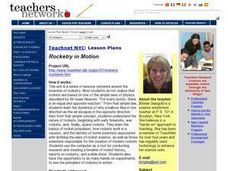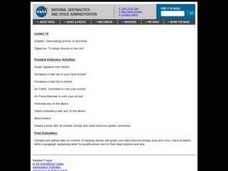Curated OER
Up Up and Away
In this technology worksheet, students find the words that are related to machines that fly and the answers are found through clicking the link found at the bottom of the page.
Curated OER
Rocketry in Motion
Students investigate why a balloon flies in one direction as air escapes in the opposite direction, which helps them understand the nature of rockets and fireworks. Individually and in teams, students conduct research to create a...
Curated OER
The Effects on Flight Characteristics/Performance Due To Variations in Design of Sled Kites.
Students expand upon previous lessons with sled kites by varying the dimensions or materials while building a news sled kite while working in a team. They fly their original kites and the new ones under similar conditions to determine...
Curated OER
Assembling an Aircraft
Young scholars practice reading directions from a task card to assemble a paper aircraft during their Moon, Mars and Beyond mission. They relate the activity to their mission work and recognize the importance of reading directions.
Curated OER
Pioneers In Space
Students discover the meaning of the word pioneer by using a variety of different activities. They are introduced to some of the pioneers of aviation in Ohio. They use coins and conduct research about some of the persons who accomplished...
Curated OER
John J. Montgomery: Controlling flight
Students research the history of aviation while looking at how gliders and airplanes fly. This instructional activity is the perfect way to intertwine Science and History. It has variations for all grade levels K-12.
Curated OER
Four Forces of Flight
Young scholars explore the four forces of flight. They investigate the four forces of flight: lift, drag, thrust and weight (gravity). They experiment with flight-testing various objects commonly found around the house and constructing...
Curated OER
Flying Objects
Students apply measurement techniques to create a flying object. They measure, draw, and cut out a flying wheel out of a six inch card.
Curated OER
Flight Unit Culminating Activities
High schoolers participate in a variety of culminating activities surrounding a unit on flight. They design and test a plane at an interactive website and then write a paragraph explaining what the qualifications are for their ideal...
Curated OER
A Time For Flight
Middle schoolers visit the Henry Ford Museum to view an exhibit on flight. They take notes using a pilot log worksheet and create a timeline. They share their timeline with the class and use the internet to gather more information.
Curated OER
How Things Fly
Students, by drawing on their own experiences, discuss and examine the basic physics of flight. They participate in a variety of activities regarding flight.
Curated OER
An Uplifting Experience
Learners examine the forces that affect the flight of airplanes through the use of paper airplanes. They conduct Internet research, conduct experiments demonstrating Bernoulli's Principle, and design and construct a paper airplane.
Curated OER
Come Fly With Me...Aviation
Students conduct internet research on aviation and pioneer aviators. They create an alphabet book r with flight related terms, write a short biography of a pioneer aviator and take part in a paper plane flying contest.
Curated OER
How Things Fly
Students research the mechanics of flight and create a slideshow with one slide dedicated to each of these topics: lift, drag, thrust, and weight. They create a short quiz regarding the material that they presented and give it to their...
Curated OER
What Makes Airplanes Fly . . . Why Me
Students investigate the historical development of human attempts to fly and the practice of keeping recorded data for historical reasons.
Curated OER
Mimicking Nature; Science, Aviation, Flight, Wings
Students consider the relationship between form and flight and investigate the history of man made flight and how wing shape and flexibility affects the maneuverability of an aircraft.
Curated OER
Airspeed Problem Set
Students demonstrate an understanding of aircraft launch airspeed requirements. They read a selection on relative velocities from a NASA Web-based textbook, then calculate airspeed launch requirement problems.
Curated OER
Wing Area Effects Problem Set
Students read an explanation from a NASA Web-based textbook on lift and an explanation on the FoilSim software package given below. They use FoilSim to evaluate the relationship between wing area and lift.
Curated OER
Aircraft Trajectory Problem Set
High schoolers read text from a NASA Web-based textbook then demonstrate an understanding of the text by using it to complete an activity on aircraft trajectories.
Curated OER
Using Graphs to Compare
Pupils use the FoilSim computer simulation program, and demonstrate an understanding of the lift variables by explaining their graphical representations. They demonstrate an understanding of forces and motion.
Curated OER
Demonstrate Flight
Students measure the distance and duration of flight . The learner compare and contrast the Blunt Nose and The Dart.






















